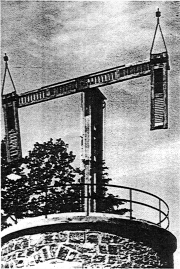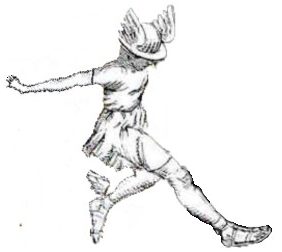
Ever since computers became known, they have been compared to the human mind, as the expressions “electronic brain,” “artificial intelligence,” and “virtual reality” testify. But comparisons cut both ways, so it is tempting to compare the human mind-or at least those mental activities that process information-with computers. 1
Computers have five major components-a central processing unit, memories, input devices, output devices, and software-each one of which has parallels in the human mind. The central processing unit corresponds to that part of the brain with which we understand and reason. Computer memories correspond to human memory. Input devices correspond to our senses. Output devices-monitors, modems, printers, and the like-have their equivalent in our voices, gestures, and other ways of communicating with others. Software is akin to training and education.
It is no coincidence that computers resemble humans in so many ways, since they are the products of human minds. Nor should we be surprised to hear of attempts to make computers ever more “human” through artificial intelligence, virtual reality devices, and other simulations. However interesting, such a comparison misses a crucial factor that futurists and pundits often ignore, namely time. Computers did not appear suddenly out of nowhere, but represent the latest phase in a very long history of humans’ attempts to enhance their mental abilities through information-handling devices and systems. To understand both computers and humans, we need to retrace the evolution of information systems.
By an information system I mean a set of techniques and artifacts used to gather, store, retrieve, and/or communicate information; in other words, technologies of the mind. For example, scientific instruments and methods of observation extend our natural powers of perception. Devices, such as the abacus, and techniques, such as double-entry bookkeeping, expand human powers of reasoning and understanding. Written, printed, and other recorded media enhance our memory. Postal, telegraph, and telephone networks extend our ability to communicate. And our ability to learn is expanded by textbooks, standardized tests, and mnemonic tricks.
Can the concept of information systems be used to understand human history? In many ways, it already has, under different labels. Linguists, archaeologists, historians, and other experts have long studied the origin and development of languages, writing, and mathematics, the impact of printing and scientific instruments, the history of cartography, and a myriad of other information systems. There is no lack of knowledge in this field. What is needed is a category to encompass all of these efforts, a typology, and a periodization.
If there were a branch of history called information systems history, it would lie at the intersection of two other well-known subdisciplines: cultural history and the history of technology. Cultural history explains how people know, what they know, and how this influences their behavior. Information systems history would describe and analyze the ways in which humans know, ignoring the content of that knowledge.
The history of technology and the history of information systems overlap even more. Many information systems, such as printing presses, telegraph networks, and computers, require artifacts and machines, the stock in trade of technology. Technology, however, is not limited to the material world. Many information systems-bookkeeping, taxonomies, the alphabetical order-have minimal hardware but considerable technique. Like the history of technology, the history of information systems would deal with the purposeful and utilitarian, but would concentrate on knowledge rather than on energy or materials.
Like everything else in human culture, information systems have evolved from simpler to more complex forms. To make sense of this evolution, we can identify several periods of innovation, or revolutions, in information systems.
The first revolution was the development of language, an information system that required no material artifacts, but greatly extended the ability to classify, remember, and communi-cate information. A second revolution centered around the introduction of writing, but it also included maps, surveying and geometry, paintings and sculptures. The materials used include clay, papyrus, parchment, stone, and their respective writing instruments, as well as sundials, water clocks, and other instruments. A third revolution involved information-handling machines, that is, artifacts with many moving parts. The printing press is the archetype, but here we also find clocks, telescopes, astrolabes, and microscopes.
The fourth information revolution, which I will describe below, coincided with the Enlightenment and with the political revolutions of the eighteenth and early nineteenth centuries. The fifth information revolution, covering most of the nineteenth century, witnessed the first large-scale application of scientific and industrial techniques to the realm of information handling. This was the age of the rotary press, photography, the electric telegraph and telephone, and numerous other information devices.
The introduction of electronic devices at the end of the nineteenth century ushered in a sixth information revolution. Radio, television, radar, and magnetic recording are among its best-known devices. Computers are also electronic devices, but with an important difference: they process information in digital form. This allows them to interface with other information devices and also to follow complicated instructions. Their appearance has made, by common consent, as revolutionary a change as the introduction of the printing press.
Several comments need to be made regarding this periodization. One is that information systems are not independent variables, but are enmeshed in the culture, politics, and economy of the societies in which they evolve, as causes or as consequences of other changes. It is no coincidence that our list of stages in the history of information systems corresponds well to the periodization we find in other areas of history. Furthermore, our periodization is layered. New innovations seldom replace older ones, but only add a layer of complexity. Computer networks have not introduced the “paperless office” or replaced newspapers. Printing did not replace handwriting, and nothing will ever stop people from talking.
Already, several scholars have used information systems as a tool of historical analysis.2 My own contribution, hopefully to be published soon, analyzes the revolution in information systems of the eighteenth and early nineteenth centuries.
Information in the Age of Reason and Revolution
The fourth revolution in information systems took place in the eighteenth and early nineteenth centuries. Unlike the “printing revolution” that preceded it or the age of electricity that followed, this period did not see a major breakthrough in information-handling hardware. Instead, it was characterized by a search for accessibility, accuracy, and efficiency. As more scientific, geographic, and other forms of knowledge became available, the educated population of Europe and the Americas responded by demanding yet more information. The age of liberal political revolutions, from 1776 to 1848, accelerated the demand for, and the supply of, information of all sorts, especially about nature, geography, and society.
This expansion resulted in numerous developments. Under perception, we note the development of sophisticated instruments-the marine chronometer, the sextant, the theodolite-but also new methods of gathering data, such as surveys and censuses. In reasoning and understanding, there were several breakthroughs: the alphabetical order, especially in technical and universal encyclopedias; taxonomies and nomenclatures in botany, zoology, and chemistry; and the presentation of data in the form of statistics. Dictionaries and encyclopedias, which proliferated, became the repositories of information organized for efficient retrieval, rather than displays of erudition. Botanical gardens and herbaria were taxonomically arranged as filing systems for plants. In the realm of communication, we note a proliferation of pamphlets, tracts, and newspapers, as well as two new telecommunications media: the Chappe semaphore telegraph on land, and naval flag signaling systems at sea.
Learning lagged behind, as it often does. Schools and universities persisted in ignoring the sciences, technology, and social and geographical disciplines well into the nineteenth century. Training in new fields took place in informal settings, by apprenticeship, or on the job.
A Research Agenda
By accepting information systems as a valid concept with which to look at the past, we raise many questions. To what can we attribute changes in information systems? Which way does causality run: From a serendipitous invention (e.g., Gutenberg’s moveable type or Morse’s code) or a new supply of information (say, a new encyclopedia or the creation of the Internet) to complex social consequences, such as bureaucracies, mass movements, or large corporations? Or from the pressure of social demand (a war, a revolution, economic growth) to the creation of new means of handling information? Or is causality itself an obsolete concept when dealing with issues of such complexity, to be replaced perhaps by multiple interactions?
Beyond evolutionary advances (telegraph to telephone, radio to television, mainframe to PC) lie the major transitions from one type of information system (and its corresponding social arrange-ment) to the next. Are these “revolutions,” through which the history of information systems seems to lurch, real or just heuristic devices we impose on history to make it easier to swallow in small doses? And what is the relationship between information systems “revolutions” and the better known political, scientific, or industrial ones?
In other words, to help us understand the past, information systems history must come up with useful definitions and a convincing periodization. It must explain the major transitions from one stage to the next as well as evolution within each stage. And it must fuse with other, more established forms of history.
Despite the considerable (and very sophisticated) scholarship that already has been devoted to the study of various information systems-writing, printing, the book, the press, the electronic media-we are only at the beginning of our voyage into the past.
Notes
1) It is important to note some striking differences between computers and human minds. Computers can store, sort, process, and retrieve information and perform calculations much faster, more accurately, and untiringly than humans can. Humans, in contrast, possess qualities that computers lack and perhaps always will, such as consciousness, creativity, and emotions.
2) A few examples: James Beniger, The Control Revolution: Technological and Economic Origins of the Information Society (Cambridge, Mass: Harvard University Press, 1986); JoAnn Yates, Control Through Communication: The Rise of System in American Management (Baltimore: Johns Hopkins University Press, 1989); Steven Lubar, InfoCulture: The Smithsonian Book of Information Age Inventions (Boston: Houghton Mifflin, 1993); Alfred Crosby, The Measure of Reality: Quantification and Western Society, 1250-1600 (Cambridge: Cambridge University Press, 1997); and Michael E. Hobart and Zachary S. Schiffman, Information Ages: Literacy, Numeracy, and the Computer Revolution (Baltimore: Johns Hopkins University Press,1998).
Daniel R. Headrick teaches history and social science at Roosevelt University. He is the author of The Tools of Empire (1981), The Tentacles of Progress (1988), and The Invisible Weapon: Telecommunications and International Politics, 1851-1945 (1991), all Oxford University Press.

You must be logged in to post a comment.